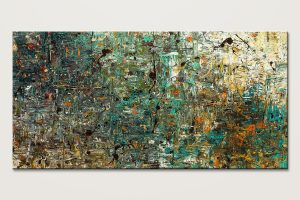Abstract Art and Abstract Artists: A Starting Point
The Visual Language
Abstract art itself is commonly defined as being a medium that utilizes a “visual language of form, color, and line to create a composition” or something that may or may not “exist with a degree of independence from visual references in the world” (Rudolph Arnheim – Visual Thinking).
One might posit that in layman’s terms, that roughly translates to something along the lines of: “the abstract artist communicates via the medium of drawing, existential messages that one cannot usually see”. Or, even simpler: the abstract artist pours interesting parts of themselves into their work, the meaning behind which can take on a variety of truths – after all, it is abstract.
Abstract can often involve being thrown in at the proverbial deep end, particularly when one has little experience of the subject matter first-hand. Perhaps the easiest way – or at least one of the easier ways – would be to be introduced to some of the masters of the genre, some of the people that have paved the way for abstract art by delivering such renowned and lauded works that they are instantly recognizable to most. So head to the library, grab some books, sit down on your recliner sofa and learn more about the following masters.

Pablo Picasso
The name that most people should immediately recognize, abstract artist or not – Pablo Picasso – belongs to the master Spanish painter who was at the forefront of the abstract movement known as Cubism during his lifetime (1881 – 1973). Quality examples of his abstract work can be found in the period in which he committed heavily to Cubism, examples such as Violin and Guitar or Femme en pleurs.
This form of abstract art, the objects that are being depicted are done so in such a way so that they resemble broken up, re-assembled versions of their former selves, akin to a jigsaw of sorts. The resultant form is an abstracted one – a person can vaguely make out the subject’s original form, but it takes some mental doing in order to do so, but the result is quite pleasing nonetheless.
Wassily Kandinsky
Around from 1866 – 1944, Kandinsky is another popular name, particularly in the field of abstract art, a movement which he contributed to greatly, along with expressionism. Pieces of note in the field of abstract would include Squares with Concentric Rings, On White II, and particularly Composition VII – a piece noted by Kandinsky himself as being perhaps the single most complex piece he ever painted and with good reason: the painting is a veritable mass of abstract ideas and design, all flowing at once and is certainly a feast for both the eyes and mind.
Kandinsky is also widely regarded as the proverbial grandfather of abstract art, often being credited with painting the very first purely abstract works. Regardless of this, it is certainly true that he contributed to the art style in great quantities, with his driving passion being “inner necessity” – it was his chief principle and the main force behind his persona and being as an artist. “Inner necessity” was Kandinsky’s devotion to inner beauty, to spiritual desire, and – to him – was the principle of art itself.
Jackson Pollock
A slightly more recent name (1912 – 1956) and someone a little closer to home for US residents, but nevertheless an incredibly important figure in the realm of abstract art. He was a chief player in the abstract expressionist movement of post-WWII America and was largely defined and recognized by his unique approach to drip painting, with his particular style being recognizable the world over.
Notable works would include Convergence, No. 5, 1948, and Male and Female. Pollack has the (un)fortunate happenstance in that his work commonly divides opinions of whether or not it actually has any merit. An alcoholic, his life was a relatively mixed bag. He was known as an exceedingly reclusive man with a volatile personality (not aided by his drink problems), who enjoyed as much fame as he did notoriety. Pollock’s work further gained in popularity and status in increasing amounts even after his alcohol-related death in 1956.
However, toil and trouble aside, it can be said of Pollock that his work has had a profound effect on the abstract world (and particularly the American art-psyche). His work is recognizable to most and that is a positive quality in and of itself for anyone.
This article was written by Beth Holden. Read the disclaimer…
PLEASE SHARE THIS:
